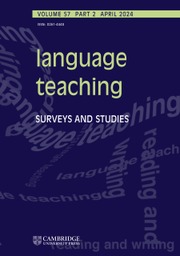Crossref Citations
This article has been cited by the following publications. This list is generated based on data provided by Crossref.
Trofimovich, Pavel
McDonough, Kim
and
Foote, Jennifer A.
2014.
Interactive Alignment of Multisyllabic Stress Patterns in a Second Language Classroom.
TESOL Quarterly,
Vol. 48,
Issue. 4,
p.
815.
Trofimovich, Pavel
and
Turuševa, Larisa
2015.
Ethnic Identity and Second Language Learning.
Annual Review of Applied Linguistics,
Vol. 35,
Issue. ,
p.
234.
Trofimovich, Pavel
Kennedy, Sara
and
Ann Foote, Jennifer
2015.
The Handbook of English Pronunciation.
p.
353.
Bird, Sonya
and
Kell, Sarah
2017.
The Role of Pronunciation in SENĆOŦEN Language Revitalization.
The Canadian Modern Language Review,
Vol. 73,
Issue. 4,
p.
538.
Levis, John M.
2018.
Plenary talk.
Journal of Second Language Pronunciation,
Vol. 4,
Issue. 2,
p.
260.
Kim, YouJin
Jung, YeonJoo
and
Skalicky, Stephen
2019.
LINGUISTIC ALIGNMENT, LEARNER CHARACTERISTICS, AND THE PRODUCTION OF STRANDED PREPOSITIONS IN RELATIVE CLAUSES.
Studies in Second Language Acquisition,
Vol. 41,
Issue. 5,
p.
937.
Schneider, Sara
Ramirez-Aristizabal, Adolfo G.
Gavilan, Carol
and
Kello, Christopher T.
2020.
Complexity matching and lexical matching in monolingual and bilingual conversations.
Bilingualism: Language and Cognition,
Vol. 23,
Issue. 4,
p.
845.
Bogach, Natalia
Boitsova, Elena
Chernonog, Sergey
Lamtev, Anton
Lesnichaya, Maria
Lezhenin, Iurii
Novopashenny, Andrey
Svechnikov, Roman
Tsikach, Daria
Vasiliev, Konstantin
Pyshkin, Evgeny
and
Blake, John
2021.
Speech Processing for Language Learning: A Practical Approach to Computer-Assisted Pronunciation Teaching.
Electronics,
Vol. 10,
Issue. 3,
p.
235.
Jiang, Lin
Luo, Yingxuan
and
Zhan, Jianling
2021.
Effect of Interaction Intensity on Alignment and EFL Learners’ Oral Production in the Reading-Speaking Integrated Continuation Task.
Chinese Journal of Applied Linguistics,
Vol. 44,
Issue. 3,
p.
314.
LASCOTTE, DARREN K.
and
TARONE, ELAINE
2022.
Channeling Voices to Improve L2 English Intelligibility.
The Modern Language Journal,
Vol. 106,
Issue. 4,
p.
744.
Cai, Dianhui
and
Huang, Liyan
2023.
Effects of input modality on alignment in continuation writing.
Journal of Second Language Writing,
Vol. 62,
Issue. ,
p.
101060.
Ulbrich, Christiane
and
Canzi, Massimiliano
2023.
Intonational alignment in second language acquisition.
Speech Communication,
Vol. 146,
Issue. ,
p.
70.
Danica, Jerotijević-Tišma
2024.
STRATEGIES FOR LEARNING PRONUNCIATION ONLINE: SERBIAN EFL LEARNERS’ PERSPECTIVE.
Fìlologìčnì traktati,
Vol. 16,
Issue. 1,
p.
50.
Ulbrich, Christiane
2024.
Phonetic Accommodation on the Segmental and the Suprasegmental Level of Speech in Native–Non-Native Collaborative Tasks.
Language and Speech,
Vol. 67,
Issue. 2,
p.
346.
Xiaofang, Qian
and
Yashu, Lu
2024.
A Study of Interactive Alignment in EFL Reading-to-Writing Continuation Tasks.
International Journal of Language and Linguistics,
Vol. 12,
Issue. 2,
p.
86.

